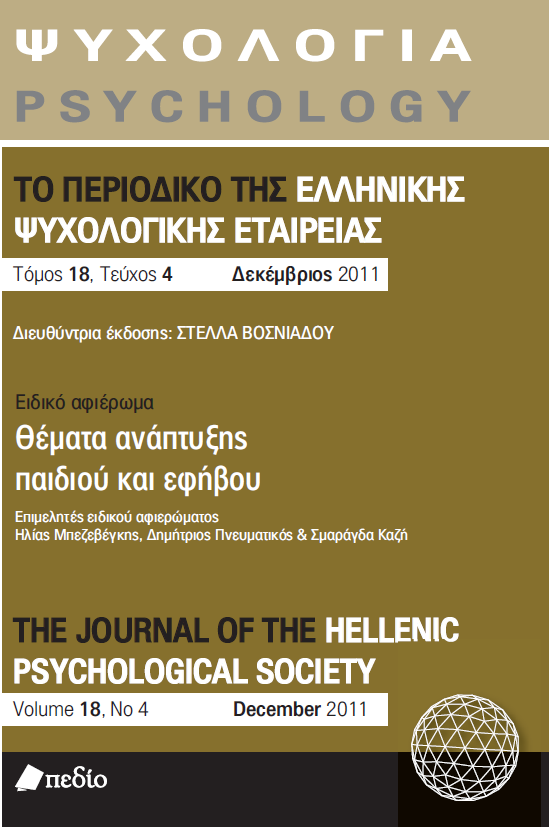Αλληλοσυντονισμός της προσοχής και γλωσσική ανάπτυξη σε νήπια με σύνδρομο Down

Περίληψη
Πολλές έρευνες καταδεικνύουν ότι στα παιδιά χωρίς αναπτυξιακές διαταραχές η ικανότητα αλληλοσυντονισμού της προσοχής (ΑΣΠ) συνιστά προϋπόθεση για την ανάπτυξη της γλώσσας. Ωστόσο, τα δεδομένα σχετικά με την ανάπτυξη του ΑΣΠ και τη σχέση του με την ανάπτυξη της γλώσσας σε παιδιά με σύνδρομο Down (ΣΝ) είναι συχνά αντικρουόμενα. Η παρούσα μελέτη έχει σκοπό να διερευνήσει την εκδήλωση συμπεριφορών ΑΣΠ σε νήπια με ΣΝ και τη σχέση τους με την κατανόηση και την παραγωγή της γλώσσας. Συμμετείχαν 10 νήπια με ΣΝ (μέση χρονολογική ηλικία: 58 μήνες) και 10 νήπια χωρίς αναπτυξιακές διαταραχές (ομάδα ελέγχου, ΟΕ) (μέση χρονολογική ηλικία: 32 μήνες) αντίστοιχου επιπέδου κατανόησης της γλώσσας. Η κατανόηση και η παραγωγή της γλώσσας αξιολογήθηκαν με τις σχετικές υποκλίμακες των δοκιμασιών πρώιμης μάθησης (Müllen, 1995), η παραγωγή λεξιλογίου με το Ερωτηματολόγιο Ανάπτυξης της Γλώσσας (Rescorla, 1989)
και οι μη γλωσσικές συμπεριφορές μέσω παρατήρησης της αλληλεπίδρασης με τη μητέρα σε ημιδομη- μένες συνθήκες παιχνιδιού. Σύμφωνα με τα αποτελέσματα, τα νήπια με ΣΝ εκδηλώνουν στατιστικά σημαντικά περισσότερες συμπεριφορές ΑΣΠ από τα νήπια χωρίς αναπτυξιακές διαταραχές. Επιπλέον, διαπιστώθηκε ότι στα νήπια με ΣΝ η παραγωγή της γλώσσας παρουσιάζει στατιστικά σημαντική αρνητική συσχέτιση με χειρονομίες που δηλώνουν αυτόβουλο αίτημα. Φαίνεται ότι τα παιδιά με ΣΝ ακολουθούν παρόμοια πορεία μετάβασης από την προγλωσσική στη γλωσσική επικοινωνία με τα παιδιά χωρίς αναπτυξιακές διαταραχές, μολονότι παρατηρείται σημαντική καθυστέρηση.
Λεπτομέρειες άρθρου
- Πώς να δημιουργήσετε Αναφορές
-
Φ. Παπαηλιού Χ., Ε. Πολεμικός Ν., Φρυσίρα Ε., Κοντάκος Α., Καΐλα Μ., Μιχαηλίδης Κ., Στρογγυλός Β., & Πολεμικού Ά. (2020). Αλληλοσυντονισμός της προσοχής και γλωσσική ανάπτυξη σε νήπια με σύνδρομο Down. Ψυχολογία: το περιοδικό της Ελληνικής Ψυχολογικής Εταιρείας, 18(4), 468–483. https://doi.org/10.12681/psy_hps.23734
- Τεύχος
- Τόμ. 18 Αρ. 4 (2011)
- Ενότητα
- ΕΙΔΙΚΟ ΑΦΙΕΡΩΜΑ

Αυτή η εργασία είναι αδειοδοτημένη υπό το Creative Commons Attribution-ShareAlike 4.0 International License.
Το περιοδικό ΨΥΧΟΛΟΓΙΑ έχει υιοθετήσει μία πολιτική Platinum open-access. Τα έξοδα υποβολής, επεξεργασίας ή δημοσίευσης των εργασιών καλύπτονται από την Ελληνική Ψυχολογική Εταιρεία. Τα πνευματικά δικαιώματα των δημοσιευμένων εργασιών προστατεύονται από την άδεια 'Creative Commons Attribution-ShareAlike 4.0 International'. Οι Συγγραφείς διατηρούν τα Πνευματικά Δικαιώματα και χορηγούν στο περιοδικό το δικαίωμα της πρώτης δημοσίευσης. Η άδεια αυτή επιτρέπει σε τρίτους, να χρησιμοποιούν την εργασία σε οποιαδήποτε μορφή, με την προϋπόθεση της διατήρησης των διατυπώσεων που προβλέπονται στην άδεια σχετικά με την αναφορά στον αρχικό δημιουργό και την αρχική δημοσίευση στο περιοδικό ΨΥΧΟΛΟΓΙΑ. Επιπλέον, κάθε διανομή της εργασίας οφείλει να γίνεται με τους ίδιους όρους διανομής, δηλαδή με την ίδια άδεια Creative Commons.




